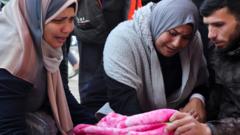While the Hamas-run health ministry, which treats its figures as reliable, reports conservative death tolls without distinguishing between combatants and non-combatants, the United Nations acknowledges that the majority of verified victims in previous reports were women and children. In contrast, the Israeli government has expressed mistrust toward these figures, claiming its own military operations have resulted in the elimination of "over 17,000 terrorists."
The complexity of the situation is exacerbated by restrictions on international media access to Gaza, including journalists from reputable organizations like the BBC. This limited access makes independent verification of on-ground realities a significant challenge. The study employed a method known as "capture-recapture," traditionally used to ascertain mortality rates in conflict zones, by analyzing overlapping death records across various reports.
The striking death toll estimates range between 55,298 to 78,525, a significant difference from the 37,877 reported by the health ministry. However, researchers caution that the estimates may vary based on the analysis' accuracy. Notably, the study found that 59% of those killed were women, children, and the elderly, highlighting the civilian impact of the conflict.
The current war, which commenced following a deadly Hamas attack resulting in 1,200 Israeli deaths and hostages taken, has sparked intense military responses, with the health ministry claiming 46,006 deaths due to Israeli actions, predominantly among civilians. This ongoing crisis continues to raise questions about the reliability of death tolls and the broader implications for humanitarian efforts and political resolutions in the region.
The complexity of the situation is exacerbated by restrictions on international media access to Gaza, including journalists from reputable organizations like the BBC. This limited access makes independent verification of on-ground realities a significant challenge. The study employed a method known as "capture-recapture," traditionally used to ascertain mortality rates in conflict zones, by analyzing overlapping death records across various reports.
The striking death toll estimates range between 55,298 to 78,525, a significant difference from the 37,877 reported by the health ministry. However, researchers caution that the estimates may vary based on the analysis' accuracy. Notably, the study found that 59% of those killed were women, children, and the elderly, highlighting the civilian impact of the conflict.
The current war, which commenced following a deadly Hamas attack resulting in 1,200 Israeli deaths and hostages taken, has sparked intense military responses, with the health ministry claiming 46,006 deaths due to Israeli actions, predominantly among civilians. This ongoing crisis continues to raise questions about the reliability of death tolls and the broader implications for humanitarian efforts and political resolutions in the region.


















